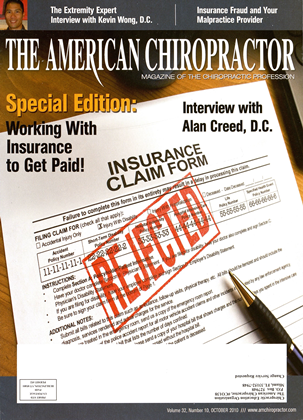1 995 WAS A VERY INTERESTING YEAR, IN FEBRUARY THE Dow JONES Industrial Average gained 30.28 points to close at 4,003.33, going above 4000 for the first time; Yahoo! was incorporated, establishing the Internet Portal as a model; a gallon of gasoline was $ 1.26 and a distinguished panel of leaders from the Council on Chiropractic Education (CCE) was assembled for a discussion on the future of chiropractic.1 The main discussion was what course the chiropractic profession should take: remain a somewhat isolated, independent health care profession, or seek integration as a member of a broader health care team. The models and methods differed slightly, but the main agreement was that as a profession we need to shape policy, participate in research and become properly positioned within the community health structure. When we look at the clinical aspect of chiropractic, just prior to this panel discussion, Eisenberg et al 1993: presented a paper stating that in 1990, chiropractic utilization on a national level was at 7%. This was published in a well respected, peer reviewed, medically indexed Journal and was reviewing Complimentary and Alternative Medicine (CAM) utilization. Now, let's fast forward....Bames et al. 2004' published a utilization rate of 7.2%. Over a 14 year span we saw the same percentage of people on a national level. When we look now at the political and regulatory component of chiropractic we see inclusions in health policy, increased funding and efforts in research, inclusion in the Department of Defense and hospital based chiropractic clinics. The tireless efforts of lobbyists, activists, chiropractic institutions and chiropractic friendly politicians have been the engine that has kept us in the game. What about the clinical front? We are the very best at educating patients and serving the community, but what have we done to promote the evidence based chiropractic research? What have we done as a profession to build legitimate relationships with medical providers within our own personal community? Never before in the history of chiropractic have we been given a political or regulatory path to a utilization rate of 95%! In 2006 a prominent medical journal published a survey of 1000 orthopaedic surgeons and their perceptions of chiropractic.4 The issues that cause many orthopaedic surgeons to not refer are open ended treatment plans, lack of evidenced based research and not understanding what we really do. The truth is our documentation is typically not that of a specialist, we don't communicate with other health providers and our teaching ends in the treatment room when it should extend to the medical doctors down the street. So. what is all the fuss about? Well the truth is the medical doctors that refer consistently are educated on chiropractic, understand what we do, received timely reports and see treatment plans that are not open ended. I had the pleasure of being involved in starting 2 hospital based clinics in the Buffalo NY area early on in my chiropractic career. The funny thing is, the survey of the orthopaedic doctors and my discussions with MDs over the years is a broken record. Over and over again they keep saying the same thing. Communicate and teach me why I should refer. That is it. There are two main categories that when corrected will lead to secure life-long referring relationships with MDs in your practice area: 1 .Learn to report properly, efficiently and consistently. This can be implemented within a single week in a busy office. 2.Establish yourself as an expert through formal credentials and be seen on a regular basis. How do I know that this works? By implementing these protocols. I have witnessed this formula to have been proven successful on the east coast, west coast and the central United States consistently. Correcting the small things and doing it time and again is generating 3-4 new MD referrals per week. Imagine if every chiropractor was getting that number of referrals from medical doctors on a small scale each and every week? Seven percent would be a number we would all laugh at. In fact, it would probably be the number of people that have NOT seen a chiropractor! Dr. Owens presently has a large personal injury practice and has successfully integrated research into his diagnostic and reporting protocols. This has resulted in him being sought after on a daily basis in the medical-legal community. Dr. Owens is one of the founding members of the American Academy of Medical Legal Profession- als and currently sits as the organizations President. Dr. Owens is certified by the Stale of New York Department of Education lo render continuing education credits to doctors of chiropractic in Accident Reconstruction. Additionally, he is credentialed by State University of New York at Buffalo School of Medicine and Biomedical Sciences to offer Category I A MA credits to medical doctors in the field of whiplash diagnosis and treatment. References: 1. http://www.dynamicchiropractic.com/mpacms/dc/article. php?id=4OIO5 2. David Eisenherg MD. Ronald Kessler PhD. Cindy Foster MPH. Frances Norlock MPH. David R. Calkins MD MPP. Thomas Delbanco MD. Unconventional Medicine in the United States - prevalence, costs and pattern of use. The New England Journal of Medicine, January 2ft. 1993. 3. David Eisenberg MD. Ronald Kessler PhD. Cindy Foster MPH. Frances Norlock MPH. David R. Calkins MD MPP, Thomas Delbanco MD. Unconventional Medicine in the United States - prevalence, costs and pattern of use. The New England Journal of Medicine, January 28. 1993. 4. Jason Busse PhD, Craig Jacobs DC, Trung Ngo DC. Robert Rodine BSc DC. David Torrence DC. JanevJim DC, Ahhaya Kulkarni MD PhD FRCPS. BradPetrisor MD FRCPS. Brian Drew MD FRCPS. Mohit Bhandari MD MSc FRCPS. Attitudes Toward Chiropractic -a survey of North American orthopedic surgeons. Spine Volume 34, Number 25. pp 2818-2825.
 View Full Issue
View Full Issue









